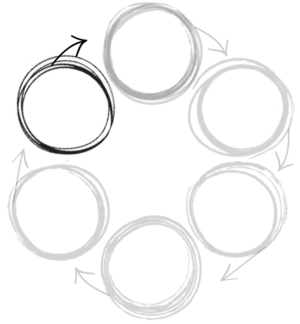The term 'feedback' commonly refers to a third party’s critique or advice about someone’s work. In the arts, this can quickly lead to controversial questions about the nature of creativity and artistic expression. At what point, and under what circumstances, can a work be considered a 'success'? What criteria would we need to apply in order to make such a judgement, and who would be qualified to apply them? This line of thought may eventually lead to questions about taste and individuality. Can we claim any level of universality, or is music an entirely cultural phenomenon?
Our working process approaches feedback from a systems design standpoint: it is a component of a system in which a portion of the output is returned to the input. In other words, feedback serves as a bridge between the end of one cycle and the beginning of another. Small-scale cycles occur whenever something is produced, judged and then revised while working on a new piece of music. We could even think of our artistic practice as a cascade of these production-judgement-revision loops stacked on top of one another, spawning new series of loops that spiral out in different directions. The first five phases of our working method address the small-scale cycles that drive systems design, material discovery, composition, rehearsal and performance. The sixth and final phase emphasizes feedback on a larger scale, reframing the outcome of one project as the beginning of the next.
Following the public presentation of a musical work, a structured session is held to reflect on the preceding working process and the resulting musical work. This is an opportunity to zoom out, examine aspects of our artistic practice, and design a strategy for moving forward. It can be useful at this point to refer to the various phases of our working model and ask ourselves questions about the downstream effects of certain decisions made during each phase. For example, was there a system-related element that did not function as expected? Was there musical material that seemed more compelling in the studio than on stage, or architectural elements of the piece that did not hold up? Was there a particularly effective moment in the performance that merits further exploration or emphasis? Were there unexpected moments that happened during the performance, and if so, were they desirable or undesirable in that musical context? Posing these types of questions to ourselves during a dedicated feedback session can help us create some distance from our artistic work, allowing us to view it critically. The answers we discover will provide orientation for the next working period.
When it comes to collaboration, the feedback phase can be especially important: it is a chance for artists to 'get on the same page' and refine their shared vision of the project moving forward. It is widely assumed that successful collaborations occur when two like-minded artists join forces and present their brainchild to the world, with their individual talents reinforcing one another to create a 'whole is greater than the sum of the parts' scenario. Hidden from view are all the differences of opinion, hours of discussion, and compromises that took place in order to produce the conditions for the final artwork to emerge. Disagreements, when handled productively, are an important part of the collaborative process and can lead to outcomes that we would not have reached otherwise.
In compositional practice, a common heuristic is to constantly ask, ‘why should it be this way, rather than one of these other options?’ When working collaboratively, this can quickly turn into, ‘why did you do it this way, instead of my preferred option?’ This is where collaborative work differs from individual work: the constant presence of another person with the ability to challenge any creative decision made at any step of the creative process. The critical factor is not whether or not the collaborators share a point of view, but rather if a point of disagreement can lead to a positive outcome that neither would have arrived at individually. In other words, we are not looking for ‘middle ground’, but rather entirely new territory that was previously inaccessible to us.
While working on aubiome, we have found that these points of disagreement vary depending on the level of detail in consideration. Working at the most granular level, that of individual musical gestures and computer behaviors, there is generally little disagreement about what works or what does not. Spending time to work at this level together, especially with the help of video review, cultivates a shared understanding of our piece as it develops and the possibility space in which it is situated.
When we zoom out to a larger view, it can be more difficult to reach an agreement. We both agree on a pool of musical material that we find interesting, but how do we create a piece out of it? Some of our most long-lasting disagreements have been over system design elements, such as how to approach a particular technological problem. When is it worth investing more time in designing a broader, more flexible element, and when is it sufficient to use a targeted, ‘hard-coded’ solution? Debates on these medium- and large-scale issues can frequently derail otherwise productive working sessions, thus we find it useful to be able to defer them for consideration during the feedback phase.











